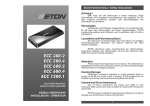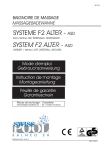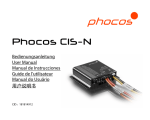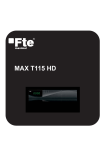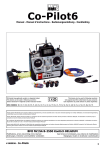Download Eton ECC 1200.1 Specifications
Transcript
INTRODUCTION Thank you for purchasing the ETON Car Power Amplifier. If, after reading your manual, you still have questions regarding this product, we recommend that you see your ETON dealer. The serial number can be found on the outside of the box. Please record it in the space provided below as your permanent record. This will serve as verification of your factory warranty and may become useful in recovering your amplifier if it is ever stolen. Serial Number: ____________________________________________________________________________ Model Number: ____________________________________________________________________________ TABLE OF CONTENTS Introduction ................................................1 Safety Instructions .....................................1 Design Features .........................................2 Installation .............................................. 3-5 Installation Considerations .....................3 Mounting Locations ...............................3 Battery and Charging.............................4 Wiring the System..................................5 Operation................................................. 6-7 Adjusting Level...................................... 6 Adjusting Crossover (X-Over)................. 6 Subsonic Filter for EC 1200.1D............ 6 Remote Control / Strapping Amplifiers for EC 1200.1D ......................................7 Specifications ............................................. 8 Troubleshooting ......................................... 8 PRACTICE SAFE SOUND™ Continuous exposure to sound pressure levels over 100dB may cause permanent hearing loss. High powered auto sound systems may produce sound pressure levels well over 130dB. Use common sense and practice safe sound. SAFETY INSTRUCTIONS This symbol with "WARNING" is intended to alert the user to the presence of important instructions. Failure to heed the instructions will result in severe injury or death. This symbol with "CAUTION" is intended to alert the user to the presence of important instructions. Failure to heed the instructions can result in injury or unit damage. CAUTION: To prevent injury and damage to the unit, please read and follow the instructions in this manual. We want you to have enjoyment from this system, not a headache. CAUTION If you feel unsure about installing this system yourself, have it installed by a qualified ETON technician. CAUTION Before installation, disconnect the battery negative (-) terminal to prevent damage to the unit, fire and/or possible injury. 1 DESIGN FEATURES A. Power Fuse: If the Fuse should blow, never replace with one of greater value than the original B. Power Connector terminals: Connects Power, Ground, and Remote. D. RCA Input Jacks - Line Level from Radio Pre-outs: The industry standard RCA jack provides an easy connection for signal level input. They are platinum to resist the signal degradation caused by corrosion. E. Level Control: This can be adjusted to match output levels from a variety of source units. F. Crossover Filter Switch: HPF for High Pass - Mid-Tweeter. Flat for All Pass - Full Range. LPF for Low Pass - Subs. G. Adjustable Crossover Frequency Control: 50-500Hz or 500Hz – 5KHz @ 12dB/octave for 2 and 4 channel models. 50-250Hz Low Pass only on Model EC 1200.1 D Mono Block. H. Remote Level Control: (EC 1200.1D Only) Gain set on the amplifier by up to -12dB I. Speaker Connections: Follow correct polarity, and do not Ground any speaker wires. Do not connect any speaker wires together. J. Pass Thru Outputs: The Pass-Thru provides a convenient source for daisy-chaining an additional amplifier without running an extra set of RCA cables from the front of the vehicle to the rear amplifier location. K. Subsonic Control: (EC 1200.1D Only) A variable 15-40Hz high pass filter designed to prevent frequencies below the audio range from being applied to the subwoofer from the amplifier. Improving subwoofer performance and power handling. L. Master/Slave: (EC 1200.1 D Only) Set the amplifier to master or slave when strapping. M. SLV IN: (EC 1200.1 D Only) When strapping, this is the slaved amplifier input from the master amplifier. N. MAS OUT: (EC 1200.1 D Only) When strapping, this is the master amplifier output to the slave amplifier. O. Crossover Mulitplier Range Switch: This is used to set the multiplier for the crossover frequencies between x 1 and x 10. The setting x 1 leaves the adjustable crossover frequency from 50Hz to 500 H, while 500 Hz to 5KHz in the setting x 10. 2 INSTALLATION INSTALLATION CONSIDERATIONS The following is a list of tools needed for installation: Volt/Ohm Meter Hand held drill w/assorted bits Wire strippers 1/8” diameter heat-shrink tubing Wire crimpers Assorted connectors Wire cutters Adequate Length-Power wire #2 Phillips screwdriver Adequate Length-Remote Turn-on Wire Battery post wrench Adequate Length-Grounding Wire This section focuses on some of the vehicle considerations for installing your new Amplifier. Pre-planning your system layout and best wiring routes will save installation time. When deciding on the layout of your new system, be sure that each component will be easily accessible for making adjustments. CAUTION: If you feel unsure about installing this system yourself, have it installed by a qualified technician. CAUTION: Before installation, disconnect the battery negative (-) terminal to prevent damage to the unit, fire and/or possible injury. Before beginning any installation, follow these simple rules: 1. Be sure to carefully read and understand the instructions before attempting to install the unit. 2. For safety, disconnect the negative lead from the battery prior to beginning the installation. 3. For easier assembly, we suggest you run all wires prior to mounting your unit in place. 4. Route all of the RCA cables close together and away from any high current wires. 5. Use high quality connectors for a reliable installation and to minimize signal or power loss. 6. Think before you drill! Be careful not to cut or drill into gas tanks, fuel lines, brake or hydraulic lines, vacuum lines or electrical wiring when working on any vehicle. 7. Never run wires underneath the vehicle. Running the wires inside the vehicle provides the best protection. 8. Avoid running wires over or through sharp edges. Use rubber or plastic grommets to protect any wires routed through metal, especially the firewall. 9. ALWAYS protect the battery and electrical system from damage with proper fusing. Install the appropriate fuse holder and fuse on the +12V power wire within 18" (45.7 cm) of the battery terminal. 10. When grounding to the chassis of the vehicle, scrape all paint from the metal to ensure a good, clean ground connection. Grounding connections should be as short as possible and always be connected to metal that is welded to the main body, or chassis, of the vehicle. MOUNTING LOCATIONS The mounting position of your amplifier will have a great effect on the sound and performance produced. Engine Compartment Never mount this unit in the engine compartment. Mounting the unit in the engine compartment will void your warranty. Passenger Compartment Mounting Mounting the amplifier in the passenger compartment will work as long as you provide a sufficient amount of air for the amplifier to cool itself. If you are going to mount the amplifier under the seat of the vehicle, you must have at least 1" (2.54cm) of air gap around the amplifier's heatsink. Mounting the amplifier with less than 1" (2.54cm) of air gap around the amplifier's heatsink in the passenger compartment will not provide proper cooling and will severely affect the performance of the amplifier and is strongly not recommended. 3 INSTALLATION BATTERY AND CHARGING To maximize the performance of your amplifier, we suggest the use of a heavy duty battery and an energy storage capacitor. WIRING THE SYSTEM CAUTION: If you do not feel comfortable with wiring your new unit, please see your local Authorized ETON Dealer for installation. CAUTION: Before installation, disconnect the battery negative (-) terminal to prevent damage to the unit, fire and/or possible injury. CAUTION: Avoid running power wires near the low level input cables, antenna, power leads, sensitive equipment or harnesses. The power wires carry substantial current and could induce noise into the audio system. 1. Plan the wire routing. Keep RCA cables close together but isolated from the amplifier's power cables and any high power accessories, especially electric motors. This is done to prevent the noise from radiated electrical fields into the audio signal. When feeding the wires through the firewall or any metal barrier, protect them with plastic or rubber grommets to prevent short circuits. Leave the wires long at this point to adjust for a precise fit at a later time. 2. Prepare the power cable for attachment to the amplifier by stripping 1/2" of insulation from the end of the wire. Insert the bared wire into the B+ terminal and tighten the set screw to secure the cable in place. NOTE: The B+ cable MUST be fused 18" or less from the battery. Install the fuse holder under the hood and prepare the cable ends as stated above. Connections should be water tight. 3. Trim the power cable within 18" of the battery and strip1/2"of insulation from the end of the wire. 4. Strip 1/2" from the battery end of the power cable and crimp a large ring terminal to the cable. Use the ring terminal to connect to the battery positive terminal. DO NOT install the fuse at this time. 5. Prepare the grounding cable for attachment to the amplifier by stripping 1/2" of insulation from the end of the wire. Insert the bared wire into the GND terminal and tighten the set screw to secure the cable in place. Prepare the chassis ground by scraping any paint from the metal surface and thoroughly clean the area. Strip the other end of the wire and attach a ring connector. Fasten the cable to the chassis using a non-anodized screw and a star washer. 6. Prepare the REM turn-on wire for connection to the amplifier by stripping 1/2" of insulation from the wire end. Insert the bared wire into the REM terminal and tighten the set screw to secure the cable into place. Connect the other end of the REM wire to a switched 12 volt positive source. The switched voltage is usually taken from the source unit's accessory lead. If the source unit does not have this output available, the recommended solution is to wire a mechanical switch in line with a 12 volt source to activate the amplifier. 7. Securely mount the amplifier to the vehicle or amp rack. Be careful not to mount the amplifier on cardboard or plastic panels. Doing so may enable the screws to pull out from the panel due to road vibration or sudden vehicle stops. 8. Connect the source signal to the amplifier by plugging the RCA cables/high level inputs into the input jacks at the amplifier. Connect the speakers. Strip the speaker wires 1/2" and insert into the speaker terminal and tighten the set screw to secure into place. Be sure to maintain proper speaker polarity. DO NOT chassis ground any of the speaker leads as unstable operation may result. 9. Perform a final check of the completed system wiring to ensure that all connections are accurate. Check all power and ground connections for frayed wires and loose connections which could cause problems. Connect to Source unit's accessory lead or switched 12v source ground of vehicle* Connect to Fuse Chassis Less than 18" Connect to Chassis Ground of vehicle* *Keep Grounds as short as possible 4 INSTALLATION NOTE: Mono amplifier speaker outputs (A & B) are wired in parallel internally. 5 O P E RAT I O N ADJUSTING LEVEL To adjust the level setting, turn the amplifier levels all the way down. Turn the source unit volume up until distortion is audible and then turn it down a bit until the distortion is inaudible This will be about two thirds all the way up on most source units Next, turn the amplifier level setting until once again distortion is audible and then back it down until the distortion is inaudible. NOTE: For a more in depth setting procedure, contact ETON Technical Support ADJUSTING CROSSOVER (X-OVER) Model EC 1200.1D only Turn the crossover adjustment knob all the way down. With the system playing at normal listening level, turn the crossover adjustment knob up slowly until the desired crossover point is achieved. All Other Models Placing the switch in the HPF position sets the amplifier to the high pass mode, enabling frequencies above the cut-off point to pass, adjustable between 50-500Hz or 500 Hz – 5KHz. Placing the switch in the Flat position sets the amplifier to the all pass mode, preventing any crossover adjustment, allowing all frequencies to pass. Placing the switch in the LPF position sets the amplifier to the low pass mode, enabling frequencies below the cut-off point to pass, adjustable between 50-500Hz or 500 Hz – 5KHz. Turn the crossover adjustment knob all the way down. With the system playing, turn the crossover adjustment knob up slowly until the desired crossover point is achieved. SUBSONIC (EC 1200.1D Only) A variable 15-40Hz high pass filter designed to prevent frequencies below the audio range from being applied to the subwoofer from the amplifier. Set this to your personal preference while listening to the system. Crossover Level Crossover Crossover Level EC 1200.1D Crossover Level Subsonis 6 REMOTE LEVEL CONTROL (EC 1200.1D Only) Mounting and installation 1. Find a location, either under the dash or near the center console, that gives easy access to the remote. 2. Using the screws supplied, install the mounting clip with the tabs towards the back. 3. Route the cable for the remote and connect to both the remote and amplifier. 4. Slip the remote onto the mounting clip until it snaps into place. STRAPPING AMPLIFIERS (EC 1200.1D Only) CAUTION: Two EC 1200.1 D amplifiers that are strapped together are not recommended for impedance loads below 2. 1. Select which amplifier of the two will be the master. and set the Master/Slave switch “out”. NOTE: Only adjustments on the master amplifier will effective in functions. 2. Connect RCA cables from the source signal to the input connection on the master amplifier. 3. Set the Master / Slave switch on the slave amplifier to the "in" position. 4. Connect a RCA cable from the MAS OUT connector on the master amplifier to the SLV IN connector on the slave amplifier. 5. Connect one of the negative (-) speaker outputs from the master amplifier to one of the negative (-) speaker outputs on the slave amplifier using a 10 gauge wire (minimum). 6. Connect one of the positive (+) speaker outputs from the master amplifier to the positive (+) terminal of the speaker being use. 7. Connect one of the positive (+) speaker outputs from the slave amplifier to the negative (-) terminal of the speaker being use. Master Slave 7 Model No. RMS power per channel Power @1Ω / channel EC 300.2A EC 500.4S ED 1200.1D N/A N/A 1135W x 1 Power @2Ω / channel 225W x2 115Wx2 + 230W x2 730W x1 Power @4Ω / channel Bridge RMS Power /channel Power @ 2Ω / channel Power @ 4Ω / channel Maximum current Signal to noise ratio THD Damping Factor Channel Separation Freq. Response (+/- 1.0 dB) Input sensitivity Fuses Input Connector Impedance LED Display RCA Input / Output Level control Slide Switch for HPF / Flat / LPF Variable Freq. Controls Frequency range for HPF / LPF Slope Subsonic Filter Frequency Range Slope 130W x 2 75W x2 + 145W x2 410W x1 2300W x 1 strapped N/A 455W x 1 52A 235W x + 440W x1 N/A 71A 101A >70 dB (@1WCEA 2006 standard) <0,02 % < 0,5% > 200 > 100 > 50 dB 10 Hz to 30 KHz 10 Hz to 250 Hz 150mV to 5V ATO 2 x 30A ATO 2 x 40A ATO 3x 30A 1 pair of RCA > 10KΩ Green LED Turn-on for Power und Turn-off for Protection display 2 RCA input / 2 RCA output 4RCA input / 2RCA output 2RCA input / 2 RCA output 1 control with 5V to 100mV variable for 2 Ch 1 switch for 2 channels 2 switches for 4 channels N/A 1 control for 2 channels 2 controls for 4 channels LPF only Switchable 50 to 500 Hz or 500 Hz to 5KHz 50 to 250 LPF only 12 dB / oct N/A N/A 15 to 40 Hz variable N/A N/A 12 dB /oct. Staggered Power (Model EC 500.4S): Two separate power supplies with two separate output sections for the front and rear channels. In essence, it is 2 completely separate amplifiers sharing the same chassis. More power is created on the rear channels to allow the performance to be delivered where it is needed most. Strapped Power (Model EC 1200.1D): The Mono Block handling subwoofer speakers sometimes need more power. The following RMS power can be achieved by strapped 2 amplifiers @14.4V: 4Ω Load per channel : 1400W x 1 2Ω Load per channel : 2300W x 1 Specifications subject to change without notice TROUBLESHOOTING Symptom Diagnosis Remedy Amplifier does not turn on. B+ or REM not between 10.5 and 15.5 volts or no voltage present Check the alternator, battery, fuse, and wiring and repair as necessary Amplifier Noise Amplifier is not properly grounded. Check wiring and repair as necessary (Turn-On Pop) Voltage spike from source unit is entering amplifier's input Connect a relay turn-on module to REM terminal if pops are eliminated with no input signal to amplifier Engine Noise Noise is radiating into signal cables Re-route signal cables away from sources of high 8 Einleitung Vielen Dank, dass Sie sich für eine ETON Endstufe entschieden haben. Bitte lesen Sie vor Gebrauch des Verstärkers die Bedienungsanleitung sorgfältig. Sie enthält viele Hinweise für den produktgerechten Umgang mit Ihrem Verstärker. Die Seriennummer finden Sie an der Außenseite der Verpackung. Bitte notieren Sie diese Nummer in dem dafür vorgesehenen Feld. Serien-Nummer: _______________________________________ Model-Nummer: _______________________________________ Inhalt Einleitung. Sicherheitshinweise Designcharakteristiken Einbau Einbauplätze Batterie und Aufladung Verkabelung d. Systems 9 9 10 11 11 12 13 Betrieb Lautstärke einstellen Crossover einstellen Subsonic Filter für EC 1200.1D Zusammenschalten von Verstärker (nur EC1200.1D) Fehlerbeseitigung Technische Daten 14 14 14 14 15 16 16 HÖRSCHÄDEN Anhaltendes, übermäßiges Ausgesetztsein von Lautstärken über 85dB kann das Hörvermögen auf Dauer beeinträchtigen. ETON Verstärker sind imstande auch Lautstärken über 85dB zu produzieren. ACHTUNG! Bitte lesen Sie alle Warnungen in dieser Anleitung. Diese Informationen sind eingerahmt hervorgehoben und eingefügt, um Sie über mögliche persönliche Schäden oder Beschädigungen von Sachwerten zu informieren. LAUTSTÄRKE UND FAHRBEWUßTSEIN Der Gebrauch von Musikanlagen kann das Hören von wichtigen Fahrgeräuschen behindern und dadurch während der Fahrt Gefahren auslösen. ETON übernimmt keine Verantwortung für Gehörschäden, körperliche Schäden oder Sachschäden, die aus dem Gebrauch oder Missbrauch seiner Produkte entstehen. 9 Designcharakteristiken A. Hauptsicherung: Sollte diese Sicherung auslösen, müssen Sie vor erneuern der Sicherung die Ursache feststellen. Kontaktieren Sie im Zweifelsfall Ihren Fachhändler. Erneuern Sie die Sicherung nie durch eine Sicherung mir höherer Amperezahl. B. Stromanschlüsse: Zum Anschluss der Plus- und Minus-Spannungsversorgung, sowie für die Einschaltspannung. D. Cinch-Eingangsbuchsen: Signaleingang von den Vorverstärkerausgängen des Radios oder anderer Signalquellen, wie z.B. DVD –Spieler, usw. E. Pegelregler: Die Pegelregler sind werkseitig auf die gängigsten Autoradios eingestellt. Sollten Sie Ihre Endstufe nicht vollständig aussteuern können, stellen Sie den Lautstärkepegel mit diesem Regler nach. F. Filterschalter: Hoch für Hochpass - Mittenhochtöner Flach für Allpass - Volles Spektrum Tief für Tiefpass - Subwoofer G . Filter Frequenz-Einstellung: 50-500 Hz bei 12 dB/Oktav. 50-250Hz LP TiefpassModus Nur bei Modellen EC 1200.1D H. Externe Lautstärkeregler: (nur bei Modell EC 1200.1 D) Zur Regelung der Ausgangsleistung Dämpft um bis zu 12 dB. I. Lautsprecheranschlüsse: Die korrekte Polarität beachten und Lautsprecherkabel nicht erden. J. Signal-Durchschleifung: Der Signalausgang ist parallel zum Signaleingang geschaltet. Sie können hier ohne Aufwand einen zweiten Verstärker anschließen. K. Subsonic-Filterregler: (nur bei Modell EC 1200.1 D) Dieser Filter vermeidet, dass Signale unterhalb der Hörgrenze an Ihren Lautsprecher gelangen und diesen zerstören. L. Master-/Slave-Schalter: (nur bei Modell EC 1200.1 D) Stellt den Verstärker bei Zusammenschaltung auf Master oder Slave ein. M. SLV IN (Slave): (nur bei Modell EC 1200.1 D) Bei der Parallelschaltung von zwei Verstärkern wirkt dieser Eingang als Slave-In. N. MAS OUT (Master): (nur bei Modell EC 1200.1 D) Bei der Parallelschaltung von zwei Verstärker ist dies der Signalausgang zum Slave-In. O. Filterfrequenz-Umschalter: Mit diesem Schalter können Sie die Übernahmefrequenz zwischen 50 Hz - 500 Hz und 500 Hz - 5kHz auswählen. 10 EINBAU Dieser Abschnitt konzentriert sich auf Erwägungen hinsichtlich des Einbaus Ihres neuen Verstärkers im Fahrzeug. Vorausplanung Ihres Systemlayouts und der besten Verkabelungsrouten spart Zeit beim Einbau. Prüfen Sie bei der Wahl eines Layouts für Ihr neues System, ob alle Komponenten leicht erreichbar sind, um Einstellungen vorzunehmen. VORSICHT: Sollten Sie nicht sicher sein den Verstärke richtig zu installieren, dann wenden Sie sich bitte an Ihren Fachhändler. VORSICHT: Vor Einbau des Verstärkers immer den Minuspol Ihrer Autobatterie abklemmen. Damit vermeiden Sie Schäden am Gerät oder Kurzschlüsse und ggf. Brandgefahr. Gehen Sie Schritt für Schritt vor: 1. Lesen Sie die Bedienungsanleitung sorgfältig durch, bevor Sie mit dem Einbau des Gerätes beginnen. 2. Klemmen Sie den Minuspol Ihrer Fahrzeugbatterie vor dem Einbau ab. 3. Verlegen Sie alle Kabel bevor Sie Ihr Steuergerät einbauen. 4. Verlegen Sie die RCA nahe beieinander. Vermeiden Sie die4 Nähe zu spannungsführenden Leitungen. 5. Verwenden Sie nur qualitativ hochwertige Kabel. 6. Beachten Sie bei der mechanischen Befestigung, dass Sie keine Benzin- oder Bremsleitungen beschädigen. Befestigen Sie den Verstärker niemals am Benzintank. Achten Sie auf ausrechenden Belüftung. 7. Verlegen Sie die Kabel niemals außerhalb des Fahrzeugs. 8. Legen Sie die Kabel nicht über scharfe Kanten. Verwenden Sie Durchführungshüllen aus Gummi, wenn Sie durch Metallteile verlegen müssen. 9. Schützen Sie die Batterie und das elektrische System IMMER durch ordnungsgemäße Verwendung von Sicherungen. Installieren Sie die Sicherung immer in der Plus Leitung. Der Sicherungsschalter sollte dabei nicht weiter als 45cm von der Batterie entfernt sein. Achten Sie beim Anschluss der Minusleitung auf eine möglichst kurze Verbindung. Der Kontakt an der Karosserie muss frei von Rost, Fett und Farbe sein. Einbauplätze Die Stelle, an der Ihr verstärkter Tieftöner eingebaut ist, wirkt sich stark auf die erzielte Soundperformance aus. Motorraum Das Gerät darf niemals im Motorraum installiert werden. Ein solcher Einbau führt zum Verlust der Garantie. Einbau im Innenraum Achten Sie beim Einbau im Innenraum immer auf genügende Luftzirkulation. Wenn der Verstärker unter dem Sitz montiert wird, ist auf einen Mindestabstand von 2,5 cm rundum zu achten. 11 EINBAU BATTERIE UND AUFLADUNG Verstärker belasten Batterie- und Ladesysteme zusätzlich. Prüfen Sie deshalb Batterie und Lichtmaschine auf deren Kapazität um Ihren Verstärker sicher betreiben zu können. Um die Leistung Ihres Verstärkers ausnutzen zu können, empfehlen wir die Verwendung von hochbelastbaren Batterien, sowie einen zusätzlichen Kondensator. VERKABELUNG DES SYSTEMS VORSICHT: Sollten Sie nicht sicher sein den Verstärker richtig zu installieren, dann wenden Sie sich bitte an Ihren Fachhändler. VORSICHT: Vor Einbau des Verstärkers immer den Minuspol Ihrer Autobatterie abklemmen. Damit vermeiden Sie Schäden am Gerät oder Kurzschlüsse und ggf. Brandgefahr. VORSICHT: Verlegen Sie die spannungsführenden Kabel nicht zusammen mit den signalführenden Kabeln. 1. Planen Sie die Kabelführung sorgfältig. Die Signalkabel zusammen verlegen. Vermeiden Sie die Nähe zu spannungsführenden Kabeln. Vermeiden Sie die Nähe zu Elektromotoren, da diese z.T. starke Streufelder verursachen. Beim Verlegen durch Metallteile oder die Feuerwand immer Gummischutzhüllen verwenden. 2. Das Stromkabel zum Anschluss am Verstärker am Kabelende auf ca. 13mm abisolieren. Das freigelegte Ende in den B+ Pol einsetzen und die Befestigungsschraube anziehen. Achtung: Das B+ Kabel MUSS mit einer Sicherung versehen sein. Diese sollte nicht weiter als 45 cm vom Pluspol der Autobatterie entfernt sein. Die Sicherungshalter im Motorraum müssen immer wasserfest sein. 3. Verwenden Sie beim Anschluss immer geeignete Kabelschuhe. 4. Isolieren Sie das Kabel für den Minuspol ca. 13mm ab und schließen Sie dieses and die GND-Buchse an. Das Minuskabel mit einer möglichst kurzen Verbindung an die Karosserie klemmen. Achten Sie dabei auf einen sauberen Kontakt mit der Fahrzeugkarosserie. 5. Verbinden Sie den +12V Schaltausgang Ihres Steuergerätes mit der REM Buchse am Verstärker. Bei Anlegen von + 12V schaltet der Verstärker auf den Betriebszustand „Ein“. 6. Den Verstärker gut am Fahrzeug oder Verstärkergestell befestigen. Achten Sie darauf, dass der Verstärker nicht an Papp- oder Plastikpanelen befestigt ist. 7. 8. Schließen Sie die RCA-Kabel an die Signal-Eingangsbuchse an. Schließen Sie die Lautsprecher an die Lautsprecherklemmen an. Achten Sie auf die richtige Polung der Lautsprecher. Achten Sie darauf, dass die Lautsprecherleitungen keinen Massekontakt haben. Vor Einschalten des Systems nochmals alle Anschlüsse auf Ihre Richtigkeit prüfen. 9. 10. Beachten Sie auch die nachfolgenden Diagramme Geschaltete 12V Spannung vom Autoradio oder anderem Singnalgerät Sicherung | Höchstens 45 cm Fahrzeugbatterie Masse (GND) kabel so kurz wie möglich halten 12 EINBAU HINWEIS: Monoverstärkerlautsprecherausgänge (A u. B) sind parallel angeschlossen. 13 BETRIEB LAUTSTÄRKE (LEVEL) EINSTELLEN Drehen Sie den Levelregler auf die niedrigste Verstärkung. Drehen sie danach die Lautstärke Ihres Zweikanal - überbrückt Steuergerätes solange hoch, bis erste Verzerrungen hörbar sind. Drehen Sie nun den Levelregler so weit auf, bis wiederum erste leichte Verzerrungen hörbar sind und drehen ihn dann zurück, bis keine Verzerrungen mehr hörbar sind. HINWEIS: Detailliertere Informationen zum Einstellungsverfahren erhalten Sie vom ETON Fachhändler. Vierkanal CROSSOVER EINSTELLEN (X-OVER) Nur bei Modellen EC 1200.1D Den Filter-Regler ganz abdrehen. Während das System bei normaler Lautstärke läuft, den bzw. 500 – 5k Hz Filter-Regler langsam aufdrehen, bis das gewünschte Klangergebnis erreicht ist. Alle weiteren Modelle Zur Wahl des High Pass-Modus den Schalter am Verstärker in die HP-Position bringen. Dadurch werden Frequenzen oberhalb des Grenzpunkts durchgelassen (kann zwischen 50 und 500 Hz; bzw. 500 – 5k Hz eingestellt werden). Zur Wahl des All Pass -Modus den Schalter am Verstärker in die FLAT-Position bringen. Dadurch wird eine Anpassung der Frequenzweiche verhindert und alle Frequenzen werden durchgelassen. Zur Wahl des Low Pass - Modus den Schalter am Verstärker in die LP-Position bringen. Dadurch werden Frequenzen unterhalb des Grenzpunkts durchgelassen (kann zwischen 50 und 500 Hz, bzw. 500 – 5k Hz eingestellt werden). Den Filter-Regler vollständig abdrehen. Während das System bei normaler Lautstärke läuft, den Filter-Regler langsam aufdrehen, bis das gewünschte Klangergebnis erreicht ist. Subsonic Filter (Nur bei Modell EC 1200.1D) Ein Hochpassfilter, das dazu konstruiert ist zu verhindern, dass unterhalb der Hörgrenze liegende Frequenzen vom Verstärker an den Subwoofer geleitet werden. Während des Hörens nach Belieben einstellen. Crossover Level Crossover Level Crossover EC 1200.1D Crossover Level Subsonis 14 EINBAU Externe Lautstärkeregler (nur im LP-Tiefpassmodus verwendbar) (Nur bei Modell EC 1200.1 D) Einbau und Installation 1. Eine Stelle unter dem Armaturenbrett oder nahe wählen, die leichten Zugriff auf erlaubt. der Mittelkonsole die Fernbedienung 2. Mit den beiliegenden Schrauben die Befestigungsklemme mit den Spitzen nach hinten einbauen. 3. Das Kabel für die Fernbedienung verlegen und Fernbedienung, als auch am anschließen. sowohl an der Verstärker 4. Die Fernbedienung in die Befestigungsklemme schieben, bis sie einrastet. BETRIEB ZUSAMMENSCHALTEN VON VERSTÄRKERN (nur bei Modell EC 1200.1D) Die EC 1200.1 D-Verstärker können paarweise aneinander angeschlossen werden, wobei ihre Ausgänge kombiniert, d.h. zusammengeschaltet werden, um eine einzelne Lautsprecherlast anzutreiben. VORSICHT: Das Zusammenschalten von zwei EC 1200.1 D-Verstärkern wird nicht für Impedanzlasten unter 2 Ω empfohlen. 1. Entscheiden Sie welcher von den beiden Verstärkern der Master ist und den Master-/Slave-Schalter in die Position „Out" bringen. HINWEIS: Nur die am Master-Verstärker vorgenommenen Einstellungen wirken sich auf den Ausgang an den angeschlossenen Lautsprecher aus. 2. Cinch-Kabel des Steuergerätes an die Eingänge des Master-Verstärkers anschließen. 3. Den Master-/Slave-Schalter am Slave-Verstärker in die Position „in" bringen. 4. Ein Cinch-Kabel vom MAS OUT Anschluss am Master-Verstärker an den SLV IN-Anschluss am Slave Verstärker anschließen. 5. Einen der negativen (-) Lautsprecherausgänge vom Master Verstärker an einen der negativen (-) Lautsprecherausgänge am Slave Verstärker mit wenigstens einem 6mm² Kabel verbinden. 6. Einen der positiven (+) Lautsprecherausgänge vom Master-Verstärker an den positiven (+) Anschluss des verwendeten Lautsprechers anschließen. 7. Einen der positiven (+) Lautsprecherausgänge vom Slave Verstärker an den negativen (-) Anschluss des verwendeten Lautsprechers anschließen. Master-Verst Steuergerät 15 Model No. Ausgangsleitstung (RMS) Stereo 1 Ohm Stereo 2 Ohm Stereo 4 Ohm Gebrückt (bridged) Power @ 2Ω / channel Power @ 4Ω / channel Maximale Strohmaufnahme Signal Rauschabstand THD Dämpfungsfaktor Kanalabstand Frequenzgang (+/- 1.0 dB) Eingangsempfindlichkeit Schutzschaltung Eingang Stecker Impedanz LED Display RCA Input / Output Level control Umschalter für HPF / Flat /LPF Variable Freq. Kontrolle: HPF /LPF Frequenzgang Flankensteilheit 7.0 Subsonic Filter: Frequenzgang Flankensteilheit EC 300.2A EC 500.4S ED 1200.1D N/A N/A 1135W x 1 225W x2 115Wx2 + 230W x2 730W x1 130W x 2 75W x2 + 145W x2 410W x1 2300W x 1 strapped N/A 455W x 1 52A 235W x + 440W x1 N/A 71A 101A >70 dB (@1WCEA 2006 standard) <0,02 % < 0,5% > 200 > 100 > 50 dB 10 Hz to 30 KHz 10 Hz to 250 Hz 150mV to 5V ATO 2 x 30A ATO 2 x 40A ATO 3x 30A 1 Paar RCA > 10KΩ Grünes LED Turn-on für Power und Turn-off für Protection display 2 RCA input / 2 RCA output 4RCA input / 2RCA output 2RCA input / 2 RCA output 1 Kontrolle mit 5V to 100mV variabel für 2 Kanäle 1 Schalter für 2 Kanäle 2 Schalter für 4 Kanäle N/A 1 Kontrolle für 2 Kanäle 2 Kontrollen für 4 Kanäle nur LPF Schaltbar 50 to 500 Hz oder 500 Hz to 5KHz 50 to 250 nur LPF 12 dB / oct N/A N/A 15 to 40 Hz variable N/A N/A 12 dB /oct. Staggered Power (Model 500.4) – Zwei getrennt arbeitende Netzteile mit ebenfalls getrennten Ausgangsstufen für die Front- und Rear-Kanäle erzeugen entsprechende Ausgangsleistungen, dort wo sie benötigt werden. Modell EC 500.4 sind effektiv zwei Verstärker in einem Gehäuse. Staggered Power (Model 1200.1D) – kann durch den Parallelbetrieb Master-Slave wie beschrieben erzeugt werden. Die Leistungen erhöhen sich dadurch auf bei 4Ω auf: 1400W x 1 bei 2Ω auf: 2300W x 1 Techn. Daten können sich ohne vorherige Bekanntgabe ändern. FEHLERBESEITIGUNG Symptom Diagnose Maßnahme Verstärker lässt sich nicht einschalten Spannung von B+ oder Fernbedienung liegt nicht zwischen 10,5 und 15,5 V oder ist nicht vorhanden Lichtmaschine, Batterie, Sicherung und Verkabelung überprüfen und ggfs. reparieren Verstärkergeräusch Verstärker hat keine ordnungsgemäße Masseverbindung Spannungsspitzen vom Steuergerät über die Signaleingänge Störgeräusche über die Signaleingangskabel Verkabelung überprüfen und ggfs. reparieren Knallgeräusch beim Einschalten Motorengeräusch 16 Relais Einschaltmodus zusätzlich einbauen Die Signalkabel im Abstand zu spannungsführenden Kabeln verlegen

















